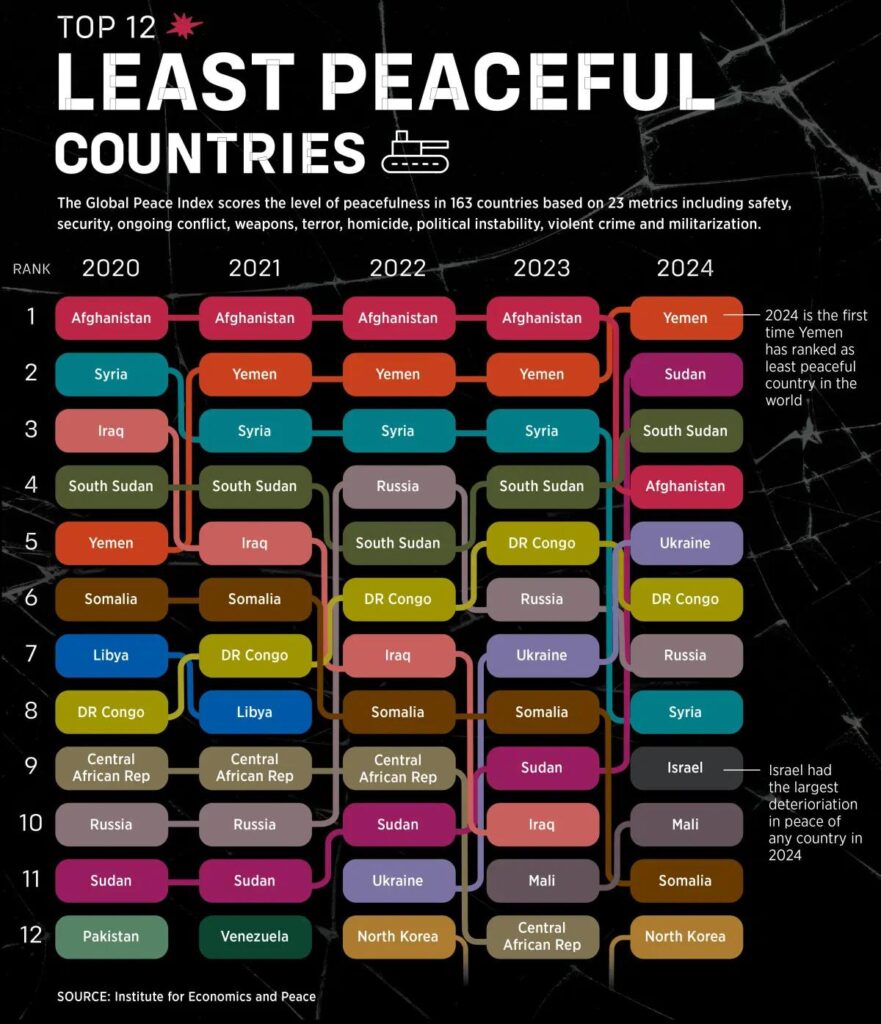Introduction
As Mexico navigates the complex landscape of security and violence in 2025, a new report from Vision of Humanity sheds light on the ten least peaceful states in the country. Following years of escalating crime rates, the analysis reveals a troubling picture of regions grappling with cartel conflicts, organized crime, and structural violence that have deeply affected the lives of their residents. From the bustling urban centers to the remote rural areas, these states face unique challenges that threaten the safety and stability of their communities. This article delves into the findings of the report, offering insights into the factors contributing to the pervasive unrest and examining the implications for local populations and national security. As the nation strives for a peaceful future, understanding the dynamics at play in these ten states is crucial for policymakers, citizens, and international observers alike.
Analyzing the Root Causes of Violence in Mexico’s Most Troubled States
The escalation of violence in Mexico’s most troubled states can be attributed to a complex interplay of factors that exacerbate social instability and contribute to crime. Corruption remains a significant issue, undermining trust in law enforcement and government institutions. In places like Guerrero and Michoacán, local officials often align with criminal organizations, perpetuating a cycle of impunity. Additionally, lack of economic opportunity drives individuals, especially youth, toward the drug trade and other illegal activities as a means of survival. High unemployment rates, coupled with insufficient public investment in education and social services, create an environment ripe for violence to flourish.
The geopolitical landscape further complicates the situation, as drug cartels vie for territorial control and dominance in lucrative markets. States such as Sinaloa and Zacatecas witness frequent clashes between rival gangs, which not only result in immediate violence but also instill fear among residents. Moreover, socioeconomic disparities are stark in these areas, where concentrated wealth exists side-by-side with poverty. Generational trauma and a culture of violence, often perpetuated through media portrayal and social norms, reinforces criminal behaviors. Understanding these root causes is essential for any attempts at implementing effective policies aimed at reducing violence and fostering peace in Mexico’s most affected regions.
Strategic Recommendations for Building Lasting Peace and Stability
To foster lasting peace and stability in Mexico’s least peaceful states, it is essential to adopt a comprehensive approach that addresses the root causes of violence and unrest. Strengthening community engagement through localized initiatives can empower citizens, encouraging them to participate in conflict resolution and educational programs that promote social cohesion. Furthermore, investing in social infrastructure—such as healthcare, education, and employment opportunities—can reduce the allure of criminal organizations by providing viable alternatives for disenfranchised populations. Collaborative efforts between government entities and NGOs can create tailored solutions that resonate with the unique cultural contexts of each region.
Moreover, establishing robust law enforcement and judicial reforms is crucial in restoring public trust and ensuring accountability. Investing in police training focused on community relations can help reduce tensions and improve safety. Additionally, incorporating transparency mechanisms within law enforcement agencies can mitigate allegations of corruption and human rights abuses. Mobilizing international support and sharing best practices from other post-conflict societies could also offer valuable insights into effective strategies for de-escalating violence and promoting peace-building efforts throughout Mexico.
Community Resilience and Local Initiatives in the Face of Adversity
As the ten least peaceful states in Mexico grapple with escalating violence and instability, local communities have risen to the challenge, showcasing remarkable resilience. Grassroots initiatives have emerged across these regions, focusing on promoting safety and restoring trust within communities. Neighborhood watch programs, community dialogues, and youth engagement initiatives are increasingly becoming vital tools to counteract the pervasive fear and division caused by crime. These programs not only foster a sense of solidarity but also empower citizens to take an active role in their security, turning from passive observers to proactive members of the community.
In addition to these initiatives, local governments are beginning to collaborate closely with non-profit organizations to implement long-term strategies aimed at social reintegration and economic development. Skills training workshops, mental health services, and educational outreach programs are being put in place to address the root causes of violence and to build a more informed and cohesive society. The table below showcases some of the most impactful local initiatives currently gaining traction in these states:
| Initiative Name | Description | Target Audience |
|---|---|---|
| Safe Neighbors | Encouraging community watch programs to enhance safety. | Local Residents |
| Empower Youth | Providing skills training to at-risk youth. | Young Adults |
| Mental Wellness | Offering free mental health services and counseling. | Families |
| Educational Outreach | Creating awareness about civic rights and responsibilities. | Students |
Wrapping Up
In conclusion, the landscape of violence and insecurity in Mexico remains a pressing concern, as illustrated by the ten least peaceful states identified by Vision of Humanity in 2025. The data reveals not only the enduring challenges posed by organized crime, drug trafficking, and social unrest but also the urgent need for multifaceted strategies to foster peace and stability. As local, state, and federal authorities grapple with these issues, the resilience of communities throughout the nation remains paramount. Understanding the complexities of these regions is essential for fostering dialogue and collaboration aimed at reducing violence and promoting harmony. Moving forward, it is crucial for stakeholders at all levels to prioritize initiatives that address the root causes of conflict, ensuring a safer and more peaceful future for all citizens in Mexico.
